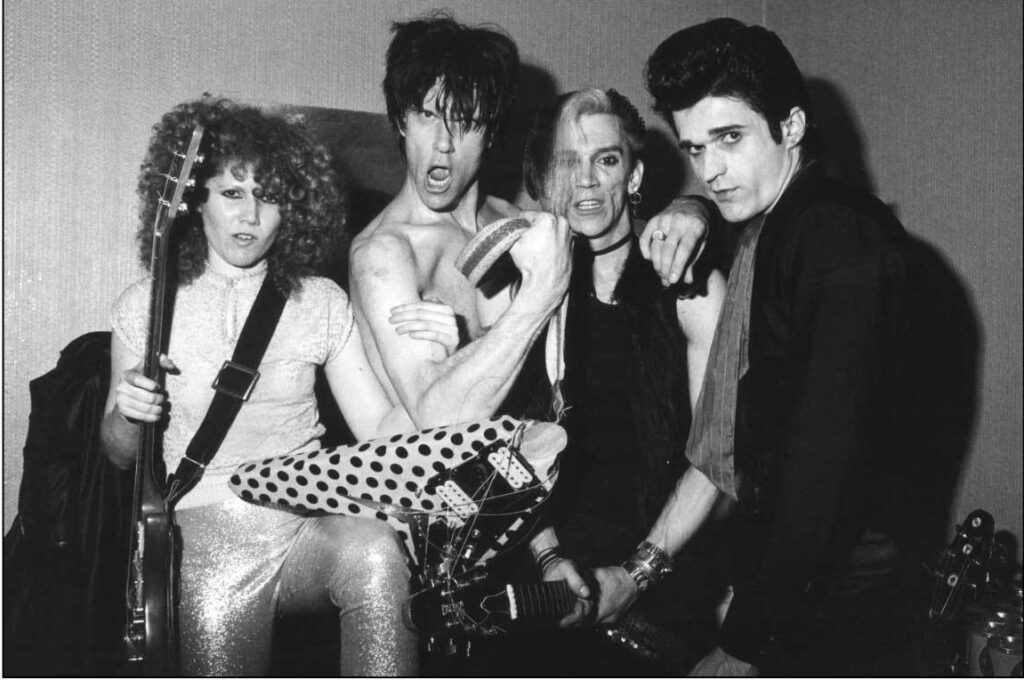Their entire body of work was heavily influenced by early rockabilly, rhythm and blues, rock and roll, and 1960s garage punk. The guys even released a series of records titled Born Bad—six volumes that gathered everyone who, in one way or another, influenced their own music.
They are often referred to as the pioneers of the “psychobilly” genre, although Lux claimed in an interview that this term fails to describe his own style of “theatrical horror blues.”
In their first mini-album, Gravest Hits, released in 1976, The Cramps attempted to explain their vision: “While punk rock spread in New York, we dove a little deeper into the rock and roll psyche for the most natural of all rhythmic impulses—rockabilly—the sound of Southern culture,” they wrote on the album cover.
“The Cramps also delved into other psychotic depths of the previous rock era: instrumental rock, surf, psychedelia, and the punk of the sixties.”
The Cramps began their journey in New York City in 1976. The original members of the band were Lux Interior (vocals), “Poison Ivy Rorschach,” and Bryan Gregory (guitars), with Miriam Linna on drums. Yes, a girl! Interior and Rorschach were originally from Cleveland, Ohio, and later got married.

When asked by New York Newsday correspondent Ira Robbins why the band didn’t have a bassist, “Rorschach” later responded, “We weren’t trying to do something radical. It’s just that none of us wanted to play bass. We gathered a huge collection of old records, and even if there is bass on them, I don’t hear it. The difference doesn’t seem significant.” The two girls in the band, “Rorschach” and Linna, also made The Cramps something unique in the testosterone-fueled punk scene of Greenwich Village.
Gravest Hits seemed to proclaim a new cult among those that already officially existed—a cult of The Cramps. The band was invited to open for the Police during their UK tour in 1979.
At that time, Linna was replaced on drums by Nick Knox, and in Melody Maker, writer Penny Kiley referred to the band as “America’s answer to the New Wave.” The Cramps were known for their outrageous “theatrical performances” on stage and their “retro” appearance, which resembled a combination of punk and trash culture simultaneously.
References to B-movies (horror films) and light sadomasochism inevitably seeped into their lyrics and performances, so “Rorschach” explained in Melody Maker: “You can’t separate music from other parts of culture; what we do is not just music. Everything I’ve ever seen on TV, everything I’ve ever eaten, everything I’ve heard on the radio—all of it influences us. We celebrate pop culture.”

As a result, the band became one of the first to use the then-novel medium of video, allowing fans to see The Cramps not just at concerts. In the late seventies, they filmed a four-minute segment inspired by classic horror films from the fifties as promotional material.
In the eighties, the solo guitarist dropped her old nickname “Rorschach” and became known as Poison Ivy. During this time, her husband performed on stage in a tight rubber jumpsuit and steel-toed boots. Chicago Tribune journalist Greg Kot wrote, “This union… is far from traditional: a man as a sexual object and a woman as the solo guitarist… it turns rock stereotypes upside down after decades.”
The first album released in the eighties, Songs the Lord Taught Us, came out on IRS Records in 1980 and was described by David Marsh of Rolling Stone as “a culture from another planet that develops rock ‘n’ roll parallel to the musical lines of our earth.” A year later, Psychedelic Jungle was released, marked by the departure of guitarist Brian Gregory and the arrival of Congo Powers on bass.
In 1984, IRS released Bad Music for Bad People, a compilation of previously released tracks from Gravest Hits and Songs the Lord Taught Us, along with songs that had only been released in the UK. MTV news anchor Kurt Loder, who wrote album reviews for Rolling Stone and was a big fan of The Cramps at the time, wrote about Bad Music for Bad People: “This is the rock ‘n’ roll that has never been on the radio, but exactly the way you imagined it.”

However, these public perceptions never had much monetary expression, and for many years, most of the vinyl material was financed by the band itself. At that time, Interior and Ivy attempted to sell already mixed material to a record company. A Date with Elvis was the fifth release by The Cramps and their third full album. It was released in 1986, when the press was going wild contemplating what Elvis’s fiftieth anniversary might be like. Ivy said in Melody Maker: “This is our tribute album to Elvis… Elvis has always been with us, but this year especially, as it was like a national year for Elvis or something like that.” A Date with Elvis received some criticism for its more than provocative lyrics, such as “Hot Pool of Womanhood” and “Cornfed Dames.” Simon Reynolds, writing a review of the album for Melody Maker, found “a few surprises on the album, with no hint of the musical radicalism” characteristic of The Cramps’ early releases.
By the late eighties, The Cramps had halted the release of new material, although they continued to appear on various compilations and import releases. Ridiculous deals and legal disputes also left little time for recording new material. For the 1990 album Stay Sick, the band—now with new bassist Candy Del Mar—recorded a couple of covers of little-known rockabilly tracks, “Bikini Girls with Machine Guns” and “Journey to the Center of a Girl,” in their unique style. Evelyn Connell gave a very positive review of the album in Rolling Stone, noting “the presence of Roy Orbison’s ghost in the sound of the guitar and vocals throughout the album, even though the music comes from hell…”
New lineup changes followed the release of Stay Sick. Del Mar left, and Slim Chance replaced her. Longtime drummer Nick Knox also left the band, and Harry Drumdini took his place behind the drum kit. Both new musicians participated in the recording of the 1994 album Flame Job—the first on a major label, Medicine, a division of Warner Bros. The band felt much more at ease on the new label. “Some record companies in the past told us that they had no place for us or that we should make a rave album, or that the demo for the new album should be given to some DJ to make a new mix out of it—such awful things,” Interior told Boston Globe. “We spent a lot of time in the past saying no, no, don’t do that, again no… feeling as if we came from Mars.”
Flame Job was a characteristic whirlpool of psychobilly from The Cramps, featuring tracks like “Swing the Big Eyed Rabbit,” “Sado County Auto Show,” and “Ultra Twist.” In his review of the album in Rolling Stone, Paul Evans noted that this psycho whirlwind and the entire trash culture of The Cramps had become a native niche for several contemporary bands, such as White Zombie, for example. Between 1994 and 1995, The Cramps performed several very successful concerts in major cities. Journalist Lorraine Ali, describing their sold-out concert in Los Angeles, wrote that their “enthusiasm, coupled with their uniqueness, is the key to the band’s longevity.”
The refusal to capitulate, despite many circumstances that had developed in the music industry over the years, also played a significant role in The Cramps’ success. In 1994, in an interview with Sullivan for Boston Globe, Interior explained why he and Ivy never dared to give everything up: “Maybe we would have thrown everything to hell if we knew something else we could do and have fun with.”
Lux Interior passed away on February 4, 2009.

